设计任务:请阅读下面学生信息和语言素材.设计一个20分钟的英语写前准备活动。 教案没有固定格式.但须包含下列要点: ·teaching objectives ·teaching contents ·key and difficult points ·major steps and time allocation ·activities and justifications 教学时间:20分钟 学生概况:某城镇普通中学高中二年级第一学期学生,班级人数40人。多数学生已经达到 《普通高中英语课程标准(实验)》
题目
设计任务:请阅读下面学生信息和语言素材.设计一个20分钟的英语写前准备活动。
教案没有固定格式.但须包含下列要点:
·teaching objectives
·teaching contents
·key and difficult points
·major steps and time allocation
·activities and justifications
教学时间:20分钟
学生概况:某城镇普通中学高中二年级第一学期学生,班级人数40人。多数学生已经达到
《普通高中英语课程标准(实验)》六级水平。学生课堂参与积极性一般。
语言素材:
A personal essay is a short piece of writing that tells about a personal experience or somethingabout a person′ s life.
Here is an example of a personal essay.

You can write about nearly any personal topic using a format like this. The student′s essay inthe Reading also used this same plan.
教案没有固定格式.但须包含下列要点:
·teaching objectives
·teaching contents
·key and difficult points
·major steps and time allocation
·activities and justifications
教学时间:20分钟
学生概况:某城镇普通中学高中二年级第一学期学生,班级人数40人。多数学生已经达到
《普通高中英语课程标准(实验)》六级水平。学生课堂参与积极性一般。
语言素材:
A personal essay is a short piece of writing that tells about a personal experience or somethingabout a person′ s life.
Here is an example of a personal essay.

You can write about nearly any personal topic using a format like this. The student′s essay inthe Reading also used this same plan.
相似考题
参考答案和解析
答案:
解析:
Teaching Contents: Write a personal essay according to the example given. Teaching Objectives:
(1) Knowledge objective
Students will have a clear mind about what a personal essay is and know how to write a personal essay.
(2) Ability objective
Students can develop the ability to analyze the structure of the passage and master the skills of writing a personalessay.
(3) Emotional objective
Students can understand life experience better and can be more confident to talk about their personal things withothers.
Teaching Key and Difficult Points:
(1) Teaching key point
Enable students to write a personal essay.
(2) Teaching difficult point
Let the students know how to write a personal essay.
Major Steps:
Step 1 Warming up and lead-in (3 minutes)
Ask students to tell about something unforgettable about their life experiences, such as a trip, a party, a date, anembarrassing experience.
(Justification: To raise the topic and make them get familiar with what they're going to talk about today.)
Step 2 Brainstorming (3 minutes)
Ask students to list the things that jump into their minds related to their personal experience.
(Justification: It helps students to have many topics to choose in their writing. )
Step 3 Sample reading and discussion (5 minutes)
Give Students the example "My favorite sport" and ask them to read it. Then divide them into groups and makethem have a discussion about the format of the passage. Then make a summary on it.
Para.1 the topic sentence
Para.2 details about the topic
Para.3 feelings about the topic
Para.4 future hopes/conclusion
(Justification: The sample reading can help students have a basic understanding of the contents of a personalessay and enable the Ss to know how to write this kind of essay. Through discussion, students' thoughts can beinspired by each others' sparkling points.)
Step 4 Mapping (5 minutes)
Ask students to select the useful information from the brainstorming and organize these ideas.
(Justification: Mapping is a useful way for students to organize contents in writing, which helps the students towrite their essay more easily.)
Step 5 Outlining (4 minutes)
Ask the students to make an outline of their personal essay and pay attention to the format when writing.
(Justification: The outlining can help students illustrate the main organizing structure and the most importantpoints of the essay and make a preparation for the drafting.)
(1) Knowledge objective
Students will have a clear mind about what a personal essay is and know how to write a personal essay.
(2) Ability objective
Students can develop the ability to analyze the structure of the passage and master the skills of writing a personalessay.
(3) Emotional objective
Students can understand life experience better and can be more confident to talk about their personal things withothers.
Teaching Key and Difficult Points:
(1) Teaching key point
Enable students to write a personal essay.
(2) Teaching difficult point
Let the students know how to write a personal essay.
Major Steps:
Step 1 Warming up and lead-in (3 minutes)
Ask students to tell about something unforgettable about their life experiences, such as a trip, a party, a date, anembarrassing experience.
(Justification: To raise the topic and make them get familiar with what they're going to talk about today.)
Step 2 Brainstorming (3 minutes)
Ask students to list the things that jump into their minds related to their personal experience.
(Justification: It helps students to have many topics to choose in their writing. )
Step 3 Sample reading and discussion (5 minutes)
Give Students the example "My favorite sport" and ask them to read it. Then divide them into groups and makethem have a discussion about the format of the passage. Then make a summary on it.
Para.1 the topic sentence
Para.2 details about the topic
Para.3 feelings about the topic
Para.4 future hopes/conclusion
(Justification: The sample reading can help students have a basic understanding of the contents of a personalessay and enable the Ss to know how to write this kind of essay. Through discussion, students' thoughts can beinspired by each others' sparkling points.)
Step 4 Mapping (5 minutes)
Ask students to select the useful information from the brainstorming and organize these ideas.
(Justification: Mapping is a useful way for students to organize contents in writing, which helps the students towrite their essay more easily.)
Step 5 Outlining (4 minutes)
Ask the students to make an outline of their personal essay and pay attention to the format when writing.
(Justification: The outlining can help students illustrate the main organizing structure and the most importantpoints of the essay and make a preparation for the drafting.)
更多“设计任务:请阅读下面学生信息和语言素材.设计一个20分钟的英语写前准备活动。 ”相关问题
-
第1题:
根据提供的信息和语言素材设计教学方案。用英文作答。
设计任务:请阅读下面学生信息和语言素材,设计一节听力课的教学方案。教案没有固定格式.但须包含下列要点:?
teaching objectives?
teaching contents?
key and difficult points?
major steps and time allocation?
activities and justifications
教学时间:45分钟?
学生概况:某城镇普通中学七年级(初中一年级)学生,班级人数40人,多数学生已经达到《义务教育英语课程标准(20i l年版)》二级水平,学生课堂参与积极性一般。
语言素材:?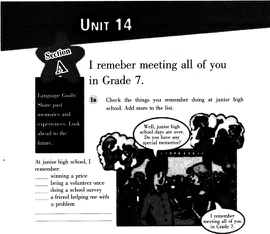
Listen and match the memory with the person.
__ Mary a. used to be scared of a teacher with high standards.
__ Frank b. remember losing a schoolbag.
__ Sarah c. remembers meeting this group of friends.
__ Peter d. has enjoyed every year of junior high school.
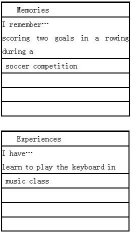 答案:解析:Teaching Content: A listening material about "I remember meeting all of you in Grade 7".
答案:解析:Teaching Content: A listening material about "I remember meeting all of you in Grade 7".
Teaching Objectives:
(1) Knowledge objectives
①Students can consolidate the usage of remember and the sentence pattern "I remember doing sth".
② Students can be more familiar with the topic of memories.
(2) Ability objectives
According to study, students can improve their skills of listening for specific information and can talk about the meaningful and unforgettable memories in English freely.
(3) Emotional objectives
① Students can find out some meaningful memories from the past experience to encourage themselves studying hard.
②Students can understand we should cherish present and do our best to create a bright future.
③ Students can improve the confidence of learning English, and are not afraid of speaking English.
Teaching Key Points:
How to make students improve their skills of listening for specific information.
Teaching Difficult Point:
How to make students use the knowledge they learnt before to talk about the things happened in the past.
Teaching Aids: a tape recorder, multimedia, pictures
Teaching Methods: Communicative Approach, Task-based Teaching Method, Audio-Lingual Approach.
Teaching Procedures:
Step 1 Lead-in (5 minutes)
The teacher shows some photos about students' junior high school and play the music named"Seasons in the Sun" to let students look back on their junior high school memories, and told them today they are going to learn to express their memories in English.
T: (after listening) Now, who can tell me what's the subject of this song
S: About youth.
T: Yes, it's about youth. Very good. This is the last unit of our English book. In this unit, we will mainly talk about our past school lives.
(Justification: This step could attract students' attention and lead in the new lesson easily.)
Step 2 Pre-listening (10 minutes)
Teacher asks students to look at the picture in this unit, and asks students to finish the task in la. Then asks students to check the things they remember doing at junior high school and add more things they remember as much as possible.
T: Now, look at the picture. What kind of party do you think it is Is it a welcome party or graduation party
S: Graduation party.
T: Look at the small pictures. What are the boy and girl talking about Try to guess!
S: (Discussing)
T: OK. Let's look at the small scenes in this big picture. What does the girl remember doing According to the pictures, please have a guess and finish the task in la. Do you understand
S: Yes!
T: And you are supposed to write down some more items about what you remember doing in your past school time. Ok, now, let's do it.
(Justification: This step can attract students' attention and help and encourage them to foucus on the content of what they are about to hear.)
Step 3 While-listening (13 minutes)
(1) Teacher asks students to listen to the tape and match the memory with the person. Then asks them to tell their answers to their partners.
T: Ok, now, let's move on to our listening. Listen to the tape and match the memory with the person. And tell your answer to your partner by using sentences, such as, Peter remembers doing homework carefully to meet the standards of a strict teacher. Are you clear
S: Yes!
T: Now, let's begin!
Students listen to the tape.
T: Ok, now, who can tell us your answers
SI: Sarah remembers losing a schoolbag ...
T: Ok, very good. Sit down, please.
$2: ...
(2) Then the teacher plays the tape again, and asks students to read after the record.
T: Now, I will play the record again and you are supposed to read after the record silently. Any questions
S: No.:
T: Ok, now, please listen to the tape. While listening, please pay more attention to the pronunciation and
intonations.
(Justification:This step make students listen and enjoy what they are listening. The task of matching the memorizing and with the person makes students focus on the listening itself. )
Step 4 Post-listening (12 minutes)
(1) The teacher asks students to make a dialogue with their deskmates by using the list in la.
T: Now, you are supposed to make a dialogue with your deskmate according to the list you wrote in la. Here is a conversation structure, you can make your dialogue according to it.
(Then the teacher writes the example on the blackboard.)
Example:
--What do you remember doing
--I remember doing my homework very late till to 12 o'clock. What do you remember doing
--Well, I remember winning a prize. And my parents took me to the biggest amusement park in our city.
--Wow!It's cool. What else do you remember
--I still remember playing basketball on the playground with you and singing songs with our best friends.
--Yes, wonderful and colorful.
The teacher chooses one student and his/her deskmate to present their dialogue in front of the class and gives
some feedback.
(2) T: Now, look at the chart on PPT, I need you to make an interview. Interview some classmates and record at least three memories of thetn. Then fill the chart and make dialogue with your deskmates. Any questions
S: No.
T: Good. Let's do it. After finished, I will invite three groups to share their dialogues, and the best group will get a reward.
(Justification: This step is easier for students' to have a high motivation to speak. According to their make dialogue with their deskmates can test the students' listening comprehension.)
Step 5 Summary and Homework (5 minutes)
Summary: Ask students to think about the key sentence structures they listened today, and then make a short summary.
Homework: Ask students to look back on their school life, and communicate these colorful feelings with their friends.
Blackboard Design:
Unit 14 I remember meeting all of you in Grade
Pre-listening:
While-listening:
Post-listening:
Example:
--What do you remember doing
--I remember doing my homework very late till to 12 o'clock. What do you remember doing
--Well, I remember winning a prize. And my parents took me to the biggest amusement park in our city.
--Wow!It's cool. What else do you remember
--I still remember playing basketball on the playground with you and singing songs with our best friends.
--Yes, wonderful and colorful.
Teaching reflection. -
第2题:
根据提供的信息和语言素材设计教学方案。用英文作答。
33.设计任务:请阅读下面学生信息和语言素材,设计一节英语听说课的教学方案。教案没有固定格式,但须包含下列要点:
·teaching objectives
· teaching contents
· key and difficult points
· major steps and time allocation
· activities and justifications
教学时间:45分钟
学生概况:某城镇普通中学八年级(初中二年级)学生,班级人数40人,多数已经达到《义务教育英语课程标准(2011版)》四级水平,学生课堂参与积极性一般。
语言素材:
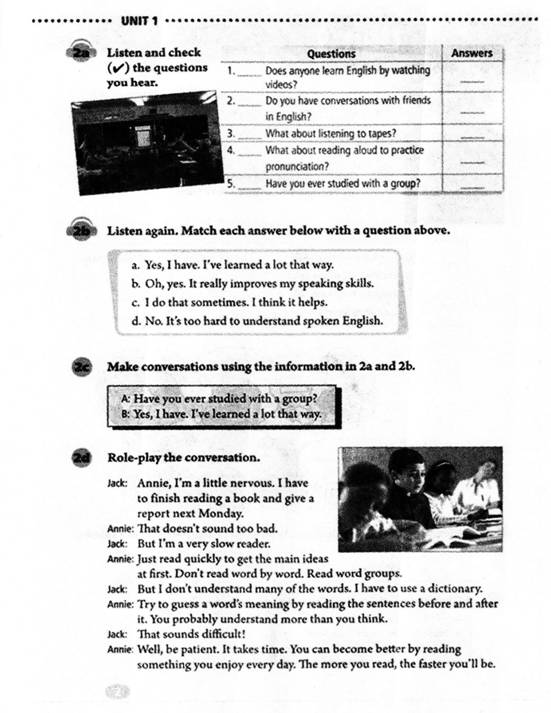 答案:解析:Teaching Content: This lesson is about the new sentence pattern"by doing". It can help the students to talk about how they study. Teaching Objectives :
答案:解析:Teaching Content: This lesson is about the new sentence pattern"by doing". It can help the students to talk about how they study. Teaching Objectives :
( 1 ) Knowledge objective
Students could master some expressions of English learning methods and sentence patterns like "I study ... by ...".
(2) Ability objective
Students could talk about how to learn English and describe their study in sentence pattern "by doing".
(3) Emotional objective
Students could help others to learn English while communicating. It can strengthen their confidence.
Teaching Key Points:
(1) Master the usage of sentence patterns like "How do you study ... I study ... by ...".
(2) Express their ideas in the "by doing" structure.
Teaching Difficult Points:
Describe English learning methods with abundant vocabulary and use these methods effectively.
Teaching Aids :
Multi-media, some related pictures.
Teaching Procedures :
Step 1 Leading in and Warming up (5 minutes)
The teacher will play a video and lead in the topic"learning to learn". Students will talk about some learning methods they know with the language structure "by doing"
(Justifications: Playing a related video will help students recall their old times of studying and make preparations for the next step.)
Step 2 Presentation (10 minutes)
(1) Students use the pictures on Page 1 to predict phrases about learning methods with the language structure "by doing".
(2) Students will do exercise from la.
(Justifications: Students will understand the usage of"by doing" better through this part. They can also master some phrases related to English learning methods.)
Step 3 Listening (10 minutes)
Students will do some listening exercises from lb, 2a and 2b. They can gain some methods to learn English while listening.
(Justifications: Students will know the usage of"by doing" completely through listening materials. Also, they can imitate pronunciation from listening materials and gain key phrases from listening exercises.)
Step 4 Practice (10 minutes)
Two students work in a group to do a conversation exercise according to the content from 2a and 2b.
(Justifications: Students can practice making conversations according to listening materials and enhance their understanding of the usage of "by doing".)
Step 5 Consolidation (5 minutes)
Two students work in a group to practice the conversation. Then change their roles.
(Justifications : Students will enhance their understanding of English learning and improve the skills of listening and speaking.)
Step 6 Summary and Homework (5 minutes)
Summary: Students will recall what they have learned today. The teacher can repeat them.
Homework: Students will do some exercise on the textbook and make sentences with "by doing".
(Justifications: This will help students recall what they have learned today and check whether they have mastered the knowledge.)
Blackboard Design :
New sentence patterns:
How do you study for a test
I study by working with a group. -
第3题:
根据提供的信息和语言素材设计教学方案。用英文作答。
设计任务:请阅读下面学生信息和语言素材,设计一个30分钟的写作教学活动。
教案没有固定格式,但须包含下列要点:?
teaching objectives
teaching contents
key and difficult points
major steps and time allocation
activities and justifications
教学时间:30分钟?
学生概况:某城镇普通中学九年级(初中三年级)学生,班级人数40人,多数学生已经达到《义务教育英语课程标准(2011年版)》三级水平,学生课堂参与积极性一般。
语言素材: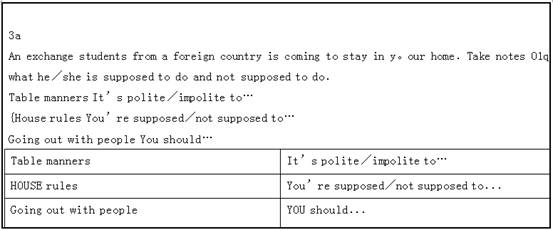
 答案:解析:Teaching Content: A class about how to writing.
答案:解析:Teaching Content: A class about how to writing.
Teaching Objectives:
(1) Knowledge objectives:
① Students will be able to know more Chinese customs, such as table manners, house rules, going out with people.
② Students can give some advice and suggestions about some Chinese customs to foreigners.
(2) Ability objective:
Students will improve their writing skills of giving advice and suggestions and improve the ability of communication.
(3) Emotional objectives:
① Students will have a deep understanding of the customs in our country.
② Students will foster their cross-cultural communication awareness.
Teaching Key Points:
How to give advice and suggestions on the rules of Chinese customs: table manners, house rules, going out with people.
Teaching Difficult Points:
How to master the expressions of Chinese customs and tell them to foreigners by letter.
Teaching Procedures:
Step 1 Pre-writing (10 minutes)
(1) Students are divided into ten groups. The teacher asks them to read 3a and discuss how to complete the chart. Then the students are asked to present their results and the teacher concludes their answers on the blackboard.
(2) Pair work
The teacher asks students to make a dialogue with their deskmates using the expressions:
①--What are the table manners
--It's polite/impolite to ...
②--What are the house rules
--You're supposed/not supposed to ...
③-How about going out with people
--You should ...
After the practice, the teacher invites two pairs to display their dialogue in the front of the class.
(Justification: This step can make students feel interested in the class and have things to write.)
Step 2 While-writing (15 minutes)
(1) Drafting
The teacher asks students to complete the letter of 3b according to the expressions in the chart. Then gives students 7 minuties to write the first draft.
(Justification: At this stage, the development of ideas are more important than getting grammatical structures, punctuation or spelling correct.)
(2) Peer editing
After the drafting, the teacher asks students to check each other's articles. They should read the notice and check the formation and the expressions. Also, they need to check carefully the grammar, spelling and punctuation of their writings. During the editing activity, the teacher offers guidance to students.
(Justification: Peer editing can provide an opportunity for students to share their writings and help them learn from each other. Proper guidance in revising can help students to know how to develop ideas and how to write clearly.)
Step 3 Post-writing (5 minutes)
The teacher invites two students to show their passages to all the students and gives them some evaluations.
Students will be encouraged to give some assessments too. Then the teacher asks students to revise their articles in both organisation and content based on the evaluations.
(Justification: At this stage, students can get some improvements in both organisation and contents. Revising their own articles can make them realize their mistakes more clearly.) -
第4题:
根据提供的信息和语言素材设计教学方案,用英文作答。
设计任务:请阅读下面学生信息和语言素材,设计一节20分钟的英语阅读活动。
教案没有固定格式,但须包含下列要点:?
teaching objectives
teaching contents
key and difficult points
major steps and time allocation
activities and justifications
教学时间:20分钟?
学生概况:某城镇普通中学七年级(初中一年级)学生,班级人数40人.多数学生已经达到《义务教育英语课程标准(2011年版)》二级水平,学生课堂参与积极性一般。
语言素材:
Mr. Cool's Clothes Store
Come and buy your clothes at our great sale! We sell all our clothes at very." good prices. Doyou like sweasters? We have green sweasters for only $15! Yellow sweasters for only $12! Do youneed trousers? For boys, we have black trousers for only $22. And shorts are only $16! For girls,we have skirts in purple for only $20. How much are our jackets? Only $30!And we have blackshoes for only $28. Socks are only $2 for three pairs!Come to Mr. Cool's Clothes Store now!答案:解析:Teaching Contents: An Advertisement about a clothes store.
Teaching Objectives:
(1) Knowledge objectives
Students can consolidate the sentence patterns "How much is ... It's ...""How much are these ... They're ...",master the phrase "at a good price" and become more familiar with the topic of shopping.
(2) Ability objectives
Students can ask about prices, talk about clothing, and use two reading strategies--skimming and scanning to get the information from the passage.
(3) Emotional objectives
Students will have a basic concept of consumption and their cooperative awareness will be improved.
Teaching Key Point:
How to guide students to use the two reading strategies--skimming and scanning to get the meaning of the passage.
Teaching Difficult Point:
How to use the reading strategy of scanning to get some specific information from sale ad.
Teaching Procedures :
Step 1 Pre-reading (5 minutes)
(1) Guessing
The teacher shows six clothing items and asks students to match each clothing item with a price.
1. a skirt __________ 2. a sweater __________3. socks __________
4. trousers__________ 5. shirts __________6. shoes __________
a.$3 b.$15 c.$20 d.$22 e.$25 f.$25
(2) The teacher shows a pair of nice shoes with the price of only $20 and a nice skirt priced at $10 on the screen.
T: If you buy something good in a low price, we can say this thing is at a good price.
Then the teacher teaches the phrase "at a good price". Students repeat the words after the teacher.
(3) The teacher asks students to pay attention to the picture and the title to predict the general idea of this passage. The teacher can ask some questions:
① What can you see in the picture
② Where are the clothes
③What's the store's name
Then the teacher encourages students to answer these questions.
(Justification: The guessing and prediction can make reading more intriguing. Teaching new phrase can make their reading much easier.)
Step 2 While-reading (9 minutes)
(1) Fast reading
T: Mr. Cool's Clothes Store has a great sale. Read the passage quickly and finish two tasks below.
① What's the main idea of the passage
②Check your guessing before.
Then the teacher checks the answers.
(2) Careful reading
According to the questions, the teacher draws a chart on the blackboard and asks students to read this ad again.
Then the teacher asks some students to fulfill the chart.
The teacher and the other students check the answers and give them some assessment.
(Justification: Fast reading can help students train their skimming skills. Filling out the table can make students pay more attention to the details of the passage, and it' s important for them to develop their scanning skills.)
Step 3 Post-reading (6 minutes)
(1) Pair work--Fill in the blanks.
T: Imagine you work at Mr. Cool's Clothes Store. Complete the conversation in pairs.
A: Hello,__________I help you
B: Yes, please. I need a __________
A: How about these purple __________
B: Oh, I like this one. How __________ is it
A: It's only __________ dollars.
B: Oh, good. I'll __________ it.
Then the teacher asks two pairs to show their dialogue to the class and gives them proper assessment.
(2) Group work--Discussion
The teacher divides the students into 8 groups and asks them to talk about what they should buy if they have $10. Then the teacher asks several students to show their ideas.
Then the teacher makes a summary:
When we go shopping, we should consider our purchasing power, and in our daily life, we should establish reasonable consumption habits.
(Justification: Pair work can help students practice how to ask about prices and talk about clothing. Group work provides students with an opportunity to communicate with others and practice their oral English.) -
第5题:
根据提供的信息和语言素材设计教学方案,用英文作答。
设计任务:请阅读下面学生信息和语言素材,设计20分钟的英语阅读教学方案。教案没有固定格式,但须包含下列要点:
·teaching objectives
·teaching contents
·key and difficult points
·major steps and time allocation
·activities and justifications
教学时间:20分钟
学生概况:某城镇普通中学七年级(初中一年级)学生。班级人数40人。多数学生已经达到《义务教育英语课程标准(2011年版)》二级水平,学生课堂参与积极性较高。 答案:解析:Teaching Contents: A passage about online shopping.
答案:解析:Teaching Contents: A passage about online shopping.
Teaching Objectives:
(1) Knowledge objectives
①Students can master the main idea of this passage.
②Students can learn the advantages and disadvantages of online shopping.
(2) Ability objective
Students can improve their reading and communicating abilities through class activities.
(3) Emotional objective
Students can improve their confidence of learning English*, and be not afraid of speaking English in class.
Teaching Key Points:
①Students can understand the advantages and disadvantages of online shopping.
②Students can comprehend the main idea of the passage.
Teaching Difficult Point:
Students can have a reasonable consumption online.
Major Steps:
Step 1 Pre-reading (6 minutes)
(1) Show some questions on the blackboard and ask students to have a discussion.
①Do you know how to buy something on the Internet
②Do you often buy things on the Interact
③What can you buy
(2) Ask students to predict the main idea of this passage.
(Justification: This step can arouse students' interest, and let them know the topic of this reading class.)
Step 2 While-reading (8 minutes)
(1) Fast reading
Ask students to read this short passage quickly in oneminute, and then conclude the main idea of each paragraph.
Ask students to examine their forecasts and conclude the main topic of this passage.
(Justification: Students can develop their skimming ability in this step.)
(2) Careful reading
Let students read this passage carefully again.
Show the table on the blackboard and ask students to discuss about the online shopping. Then ask some studentsto share their answers.
(Justification: Different ways of exploiting the text can help students not merely to cope with one particular textin class but to develop their reading strategies and reading ability.)
Step 3 Post-reading (6 minutes)
Choose two volunteers to have an interview about online shopping. One student acts as interviewer and the otherinterviewee. The knowledge they have learned in this class needs to be used in this interview.
(Justification: Students have the interview in their own way, which helps to make practical use of what they learnin this period. At the same time, students can have a better understanding of the topic.) -
第6题:
根据提供的信息和语言素材设计教学方案,用英文作答。
设计任务:请阅读下面学生信息和语言素材,设计一节英语读写课的教学方案。教案没有固定格式,但须包含下列要点:?
teaching objectives
teaching contents
key and difficult points
major steps and time allocation
activities and justifications
教学时间:45分钟?
学生概况:某城镇普通中学七年级(初中一年级)学生,班级人数40人,多数已经达到《义?
务教育英语课程标准(2011版)》二级水平,学生课堂参与积极性一般。
Listen and write these city names in the boxes above.
Beijing Moscow Toronto Boston Shanghai
Imagine you are in one of the placesin la. Talk about the weather with your friend on the phone. 答案:解析:【参考设计】
答案:解析:【参考设计】
Teaching Contents: A lesson about describing the weather.
Teaching Objectives:
Knowledge objectives
(1) Students could have a good command of these following words.
rain, windy, cloudy, sunny, snow, weather
(2) Students could master these following sentence patterns.
How' s the weather
It's cloudy./It's sunny./It's raining.
Ability objective Students could know how to describe the weather.
Emotional objectives
(1) According to the guide of teaching, students could cultivate the good habits of protecting environment and other natural resources.
(2) According to talk about the weather, students could learn how to get on well with others.
Teaching Key Points:
Master the vocabularies and sentence patterns expertly.
Teaching Difficult Point:
Learn how to describe different weather in different places.
Teaching Aid:
Multi-media
Teaching Procedures :
Step I Lead-in (5 minutes)
The teacher uses multi-media to present some pictures of different weather.
T:"There are many different weather in different seasons. Different weather has different meanings to our life.
This class we will learn the weather. Now everyone has to speak out different kinds of weather as many as possible and the one who speak out the most will get a red paper star."
(Justification: These pictures on the screen can help students to know what they will learn this class. The brainstorming will stimulate their interests and incentives. )
Step 2 Presentation (15 minutes)
(1) The teacher plays the tape and asks them to listen to the tape recorder and guess the weather. At the same time, write the important sentence pattern "How's the weather " on the blackboard.
(2) Guide students to observe the weather in the five places and finish la.
(3) Make students listen to the tape, and then write the right places (lb) in the boxes above (la).
(Justification: At this step, their ability of listening for specific information will be well developed, and their participation will increase. The teacher also could guide them to speak out the key sentences.)
Step 3 Practice (10 minutes)
(1) Pair work
①Two students in a pair, speak out the weather in the five places, and check the answer of lb.
② Make a dialogue to ask the weather.
S1: How's the weather
$2: It's rainny. How's the weather in Beijing
SI: It's sunny.
(2) Group work
The teacher gives a sentence pattern"Look!The weather in ... is ...". Let students complete the sentence by using the words they have learned. Ten students in a group, which group do the best in ten minutes will be given some gifts after the class.
(Justification: This step is mainly to practice their speaking and listening skills by putting the knowledge into their daily life. This activity can let them enjoy the study.)
Step 4 Consolidation (lO minutes)
Students should write down the words they have heard from the teacher. Then check the words, if there is a mistakes, they need more practice after class.
(Justification: This step will deepen students' impression of these words and make students realize their mistakes. It's also make students know how to review after class.)
Step 5 Summary and Homework (5 minutes)
Summary: The teacher asks one student to give a summary for this class.
Homework: The teacher asks students to review the new words they have learned in this class and try to make sentences using them.
(Justification: Summary can help students to consolidate the knowledge what they have learned in the class and the homework gives a guidance for review.)
Blackboard Design:
Words: Sentences:
rain, windy, cloudy, How's the weather
sunny, snow, weatherIt's cloudy./It's sunny./It's raining.
Teaching Reflection. -
第7题:
根据提供的信息和语言素材设计教学方案,用英文作答。
设计任务:请阅读下面学生信息和语言素材,设计20分钟的英语听说教学方案。
该方案没有固定格式,但须包含下列要点:
·teaching objectives
·teaching contents
·key and difficult points
·major steps and time allocation
·activities and justifications
教学时间:20分钟
学生概况:某城镇普通中学初中一年级(七年级)学生,班级人数40人,多数学生已经达到《义务教育英语课程标准(2011年版)》二级水平。学生课堂参与积极性一般。
语言素材: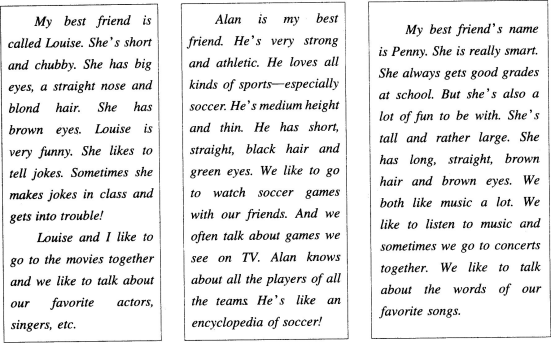 答案:解析:Teaching Contents: These three passages are about the descriptions of friends and the things they do together.
答案:解析:Teaching Contents: These three passages are about the descriptions of friends and the things they do together.
Teaching Objectives:
(1) Knowledge objectives
Students can learn some new words and expressions such as "chubby, athletic" to describe a friend's appearance,character, interests and what they like to do.
(2) Ability objectives
①Students can develop the ability to describe a friend' s appearance, character, interests and what they like to do.
②Students can improve their listening and speaking skills.
(3) Emotional objectives
Students can get a deeper understanding about friendship and strengthen the friendship with friends.
Teaching Key and Difficult Points:
(1) How to make students learn to describe a friend.
(2) How to make students improve the listening and speaking skills.
Major Steps:
Step 1 Pre-listening (5 minutes)
The teacher asks students the following questions:
(1) Who is your best friend What does he/she look like'
(2) What does he/she like to do What do you usually do
(Justification: Questions about students' friends can arouse their interest and prepare them for the class.)
Step 2 While-listening (9 minutes)
(1) Listen to the tape and fill in the blank.
(2) Listen to the tape again and finish the following question of each person: What do you like to do together
(Justification: This step helps students to get a better understanding about the listening material.)
Step 3 Post-listening (6 minutes)
(1) Show the tape scripts on the PPT.
(2) Group discussion: Talk about your ideal friends.
Then the teacher asks some students to share their ideas, then makes a conclusion about friendship andemphasizes the importance of friendship.
(Justification: This step helps students to train their speaking abilities and further their understanding aboutfriends and friendship.)
(备注:本方案设计是按照PWP模式设计的,以“听力”为主线,在听的过程中穿插“说”的活动,以提升学生的听说能力,也可以依据3P模式进行设计。) -
第8题:
根据提供的信息和语言素材设计教学方案,用英文作答。
设计任务:请阅读下面学生信息和语言素材,设计20分钟的英语听说教学方案。教案没有固定格式.但须包含下列要点:
·teaching objectives
·teaching contents
·key and difficult points
·major steps and time allocation
·activities and justifications
教学时间:20分钟
学生概况:某城镇普通中学初中一年级第二学期学生,班级人数40人。多数学生已经达到《义务教育英语课程标准(2011年版)》二级水平。学生课堂参与积极性一般。
语言素材:
Conversation 1
Tom:Hey,Peter.
Peter:Hi,Tom.
Tom:How′s the weather down there in Shanghai?
Peter:It′s cloudy.How′s the weather in Moscow?
Tom:It′s snowing right now.
Conversation 2
Peter:Hi,Aunt Sally.
Aunt Sally:Hello,Peter.
Peter:How′s the weather in Boston?
Aunt Sally:Oh,it′s windy.
Conversation 3
Peter:So,how′s the weather in Beijing?
Julie:It′s sunny.
Conversation 4
Peter:Hi,Uncle Bill.
Uncle Bill:Hello,Peter.
Peter:How′s the weather in Toronto?
Uncle Bill:It′s raining,as usual!答案:解析:Teaching Contents:Four dialogues about the weather.Teaching Objectives:
(1)Knowledge objectives
①Students can master some words of weather,such as"cloudy,snow,windy,sunny,rain".
②Students can talk about weather with others by using the sentence patterns"How's the weather in...?""It's...".
(2)Ability objectives
①Students can improve their listening abilities through extensive listening and intensive listening.
②Students can develop their speaking abilities by role play.
(3)Emotional objectives
①Students are willing to communicate with each other in English.
②Students can become interested in using English to describe weather in their daily life.
Teaching Key Point:
Students can master the words about weather and sentence patterns"How's the weather in...?""It's...".
Teaching Difficult Point:
Students can use new sentence patterns to talk about the weather correctly.
Major Steps:
Step 1 Pre-listening(4 minutes)
Teach these new words by presenting pictures of different weather conditions on the screen,and then,let students?read the words after the tape.
(Justification:This step can arouse students'interest and pave the way for students'listening activity.)
Step 2 While-listening(10 minutes)
Task 1
Play the tape and ask students to summarize the main idea,then talk about and write down which cities are?mentioned in the listening material.
For example:Shanghai,Moscow,Boston,Beijing,and Toronto.
Task 2
Ask students to listen to the tape for the second time and fill in the following table.

Task 3
Ask students to find out the key sentences describing weather.Then let students learn the sentence patterns by?changing the underlined part into the new words.
E.g.--How's the weather inBeijing?
--It's sunny.
(Justification:Through extensive listening,students will grasp the main content of this listening material.Through intensive listening,students will enhance their ability of grasping specific information.)
Step 3 Post-listening(6 minutes)
Group work:Role play
Ask students to do a role play in groups of four.Students act as weather reporters to give weather forecast of?different cities in turn.After 5 minutes,each group will choose a representative to perform it in front of the class.
For example:
Good morning,ladies and gentlemen.Here is the weather forecast of our city.It's cloudy tomorrow,and it's?very cold,so you should wear more clothes when you go outside.It has a strong wind in the afternoon,and it will be?raining the day after tomorrow.
(Justification:With practice,students can not only review the knowledge that they have learned,but also develop?their speaking ability.)
名师如何巧解题?查看视频解析>> -
第9题:
请认真阅读下列材料,并按要求作答。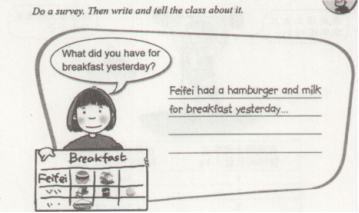
请根据上述材料完成下列任务:
(1)简述如何激发小学生的写作兴趣。
(2)如指导小学生学习,试拟定教学目标。
(3)依据拟定的教学目标,设计导入和写前环节的教学活动并说明设计理由。答案:解析:(1)激发小学生写作兴趣的措施 ①开展丰富多彩的实践性活动,以生动活泼的形式去激发学生的写作兴趣,帮助学生消除畏难情绪,使学生敢于写。
②引导学生观察生活,并引导学生阅读学习一些写作素材,使学生有话可写。
③采取有效的激励措施,激发学生的写作兴趣,如开展作文评比活动、优秀作文赏析活动等,使学生乐于写。
(2) Teaching Aims
Knowledge aim: Students can have a better understanding of how to write short passages.
Ability aim : Students can write and talk about their diet plan in their daily life.
Emotional aim : Students become more interested in English and know the importance of keeping a healthy diet.
(3)导入和写前环节
Warming up and lead-in:
①Daily greeting.
②Show some food on PPT and ask students what their favorite food are and why.
【设计意图】
从生活角度出发,有利于激发学生的学习兴趣,提高课堂参与度,营造学习氛围。
Pre-writing :
The teacher firstly tells the students the writing topic. And then they need to have a talk about their food forbreakfast. After that, the teacher can provide some useful words and sentence patterns. And also the teacher canshow a writing model, which includes a basic structure.
【设计意图】
写前交代清楚所写话题及所涉及的一些词汇、句式结构等,有利于帮助学生消除畏难情绪,激发学生的写作欲。 -
第10题:
问答题根据提供的信息和语言素材设计教学方案,用英文作答。设计任务:请阅读下面学生信息和语言素材,设计20分钟的英语听力教学方案。该方案没有固定格式,但须包含下列要点:●teaching objectives●teaching contents●key and difficult points●major steps and time allocation●activities and justifications教学时间:20分钟学生概况:本班为中等城市普通学校初中一年级(七年级)学生,班级人数45人,多数学生已经达到《义务教育英语课程标准(2011年版)》二级水平。学生能够积极参与课堂活动,合作意识较强。语言素材: A: How much is the hat? B: The hat is six dollars. A: And how much are the shorts? B: Oh, they're eight dollars. A: And the sweater? How much iS the sweater? B: Let's see.The sweater is nine dollars.正确答案:解析: -
第11题:
单选题设计任务:请阅读下面学生信息和语言素材,设计20分钟的英语听力教学方案。该方案没有固定格式,但须包含下列要点:●teaching objectives●teaching contents●key and difficult points●major steps and time allocation●activities and justifications教学时间:20分钟学生概况:本班为中等城市普通学校初中一年级(七年级),班级人数45人。多数学生已经达到《义务教育英语课程标准(2011年版)》二级水平。学生能够积极参与课堂活动,合作意识较强。语言素材:AHow much is the hat?
BLet's see. The sweater is nine dollars.
正确答案: A解析: -
第12题:
问答题根据提供的信息和语言素材设计教学方案,用英文作答。 设计任务:请阅读下面学生信息和语言素材,设计20分钟的英语听说教学方案。 该方案没有固定格式,但须包含下列要点: • teaching objectives • teaching contents • key and difficult points • major steps and time allocation • activities and justifications 教学时间:20分钟 学生概况:某城镇普通中学初中一年级(七年级)学生,班级人数40人,多数学生已经达到《义务教育英语课程标准(2011年版)》二级水平。学生课堂参与积极性一般。 语言素材:正确答案:解析: -
第13题:
根据提供的信息和语言素材设计教学方案,用英文作答。
设计任务:请阅读下面学生信息和语言素材,设计15分钟的英语听说教学方案。教案没有固定格式,但须包含下列要点:
●teaching objectives
●teaching contents
●key and difficultpoints
●major steps and timeallocation
●activities andjustifications
教学时间:15分钟
学生概况:某城镇普通中学七年级(初中一年级)学生,班级人数40人。多数学生已经达到《义务教育英语课程标准(2011年版)》二级水平。学生课堂参与积极性不高。
语言素材:
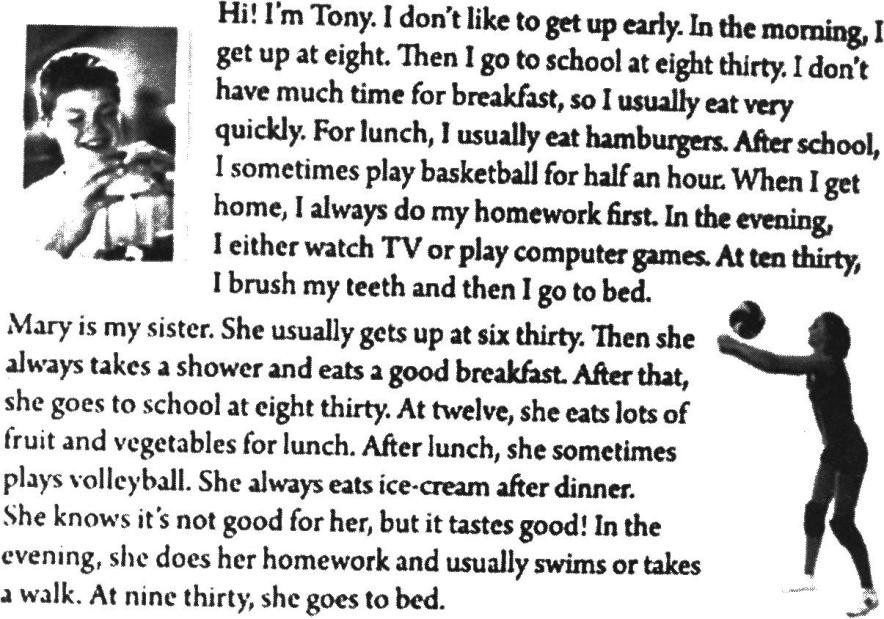 答案:解析:Ⅰ.Class Type: Listening and Speaking Class
答案:解析:Ⅰ.Class Type: Listening and Speaking Class
Ⅱ.Teaching Contents: The passage is about habitsof Tony and Mary.
Ⅲ.Teaching Objectives:
(1) Knowledge objectives
①Students can master themeaning and usage of frequency words:usually, always and sometimes.
②Students can review the usage of simple presenttense.
(2) Ability objectives
①Students can understandthe main content and grasp detailed information of the listenning material byusing different listening strategies, such as summarizing and selectivelistening..
②Students can use simplepresent tense to talk about their daily activities.
(3) Emotional objective
Students can learn theimportance of good habits and cultivate healthy habits.
Ⅳ.Teaching Key andDifficult Points:
(1) Teaching key points
①Students can get themain topic and specific information of the material.
②Students can use thewords and simple present tense to talk about their daily activities (2)Teaching difficult point
Students can apply listening strategies, such assummarizing and selective listening and listening for specific information inlistening practice.
Ⅴ.Major Steps:
Step 1 Pre-listening(3minutes)
Ask students somequestions as following to share their daily life in group of four, and choosethree representatives to share their ideas.
(1) What time do youusually get up on school days
(2) What time do youhave breakfast
(3) Do you have somehealthy/unhealthy habits
(Justification: Throughgroup discussion, students can get farmiliar with the topic, and strengthentheir cooperative spirit and speaking abilities.)
Step 2 While-listening (8minutes)
1.Extensive listening
Ask students to listen tothe tape for the first time and answer the question: What is the main idea ofthe listening material
2. Listen to the tapeagain and respectively circle the activities Tony and Mary do.
3. Intensive listening
Ask students to 1istento the tape for the second time and fill in the following table.

(Justification: Throughextensive listening, students will grasp the main content of this listeningmaterial and through intensive listening, students will enhance their abilityof grasping specific information.)
Step 3 Post-listening (4minutes)
l. Read the script afterthe tape.
2. Interview : Askstudents to work in a group of 3 and interview their partners about theirhabits. Invite some volunteers to make a report in the front of the class andgive them feedback.

(Justification: Students can realize the importance of cultivatinga good habit, develop their listening and speaking abilities and enhance theirawareness of cooperating with others.) -
第14题:
根据提供的信息和语言素材设计教学方案,用英文作答。?
设计任务:请阅读下面学生信息和语言素材。设计一节英语口语课的教学方案。教案没有固定格式,但须包含下列要点:?
·teaching ;objectives?
·teaching ;contents?
·key ;and ;difficult ;broints?
·major ;stebrs ;and ;time ;allocation?
· ;activities ;and ;justifications?
教学时间:45分钟?
学生概况:某城镇普通中学九年级(初中三年级)学生,班级人数40人,多数已经达到《义务教育英语课程标准(2011版)》四级水平,学生课堂参与积极性一般。?
语言素材:?
;Boy ;1: ;Wow, ;how ;luck!?
;Girl ;1 ;: ;What ;would ;you ;do ;if ;you ;won ;the ;lottery??
;Boy ;1 ;: ;If ;I ;won ;the ;lottery, ;I'd ;give ;the ;money ;to ;the ;Zoo. ;I ;want ;to ;helbr ;the ;brandas.?
;Girl ;1 ;.. ;That's ;a ;good ;idea ;! ;I ;know ;what ;I' ;d ;do. ;If ;I ;won ;the ;lottery, ;I' ;d ;buy ;a ;big ;house ;for ;my ;family.?
;Girl ;2.. ;Really? ;I'd ;brut ;the ;money ;in ;the ;bank. ;Then ;I'd ;just ;watch ;it ;grow!?
;Boy ;2: ;Hmm ;... ;I ;think ;I'd ;give ;the ;money ;to ;medical ;research. ;I'd ;want ;to ;helbr ;other ;breobrle.?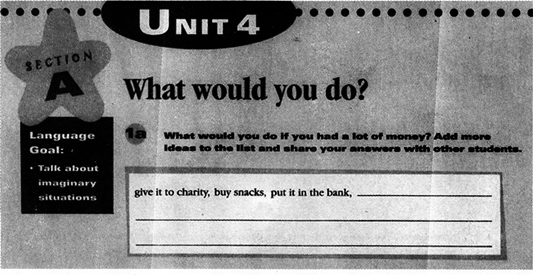
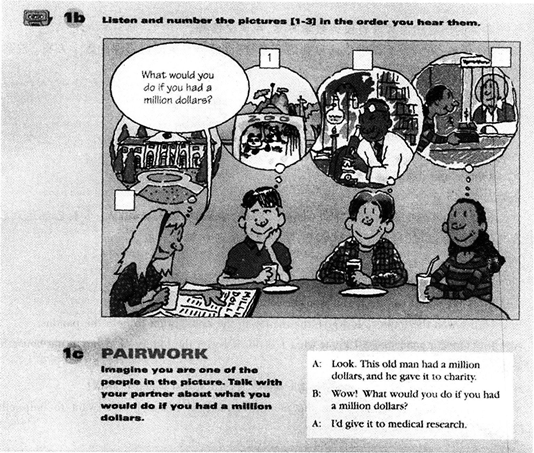 答案:解析:Teaching Contents: In this class, students could control the structure"I would / I'd do" to talk about the imaginary situations. Teaching Objectives ..
答案:解析:Teaching Contents: In this class, students could control the structure"I would / I'd do" to talk about the imaginary situations. Teaching Objectives ..
?( 1 ) Knowledge objective
①Key Vocabulary
lottery, million, medical, research
②Target Language
Look!This girl won a million dollars in the lottery.
Wow! What would you do if you won a million dollars?
I'd give it to medical research.
③ Structure
I would / I'd do
?(2) Ability objective
Students' listening ability will be well improved.
(3) Emotional objective
Students can be more interested in English. Students should remember it's really being cool to realize your dream through great efforts.
Teaching Key Points:
(1) Target language
(2) The structure: I would / I'd do
Teaching Difficult Point:
The structure : I would / I' d do
Teaching Aid :
A tape recorder
Teaching Procedures:
Step 1 Revision (3 minutes)
Review the structure "should be allowed to" by asking students to make sentences about school rules.
(Justification: The revision can examine students' learning effect and easily lead in the text.)
Step 2 Presentation (25 minutes)
la
This activity focuses on vocabulary and structures introduced in the unit.
Read the instructions to the class.
Call students' attention to the words in the box. Ask a student to read them to the class.
T: What would you do if you had a lot of money?Add more ideas to the list.
Then share your answers with other students.
Get students to complete the task. First individually, then in groups.
As they work, walk around the room checking progress and offering any help they may need.
Collect answers from students on the blackboard.
Answers will vary but should include a mixture of ideas for helping themselves and others.
1b
The teacher reads the instructions to the class, and reads the question in the speech bubble, then explains the word "lottery" to students.
T: You will hear teenagers talking about what they would do if they won the lottery.
Point to the pictures. Ask students to describe them one by one.
For example, for Picture One, a student might say, "If I won the lottery, I' d buy a big house."
Point out the sample answer.
T: The first picture you will hear about has the number one on it.
Play the recording for the first time. Students only listen.
Play the recording again. This time students listen and number the pictures in the order they hear them.
Check the answers.
?(Justification: This step can arouse students' interests and presents the target language in spoken conversation.)
Step 3 Practice (12 minutes)
Read the instructions to the class in order to call students' attention to the conversation in the box. Then,explain the vocabulary words"million" and"medical research". Finally, invite a pair of students to read it to the class.
?S1 : Look ! This girl won a million dollars in the lottery.
?S2: Wow! What would you do if you won a million dollars?
?S1 : I'd give it to medical research.
?Write it on the blackboard.
?T: Pretend you are the people in the picture. Talk with your partner about what you would do if you won a million dollars.
Get students to work in pairs. As they work in pairs together, walk around the room offering language support as needed.
After students have had a chance to practice several exchanges, ask pairs to come to the front of the classroom and act out their conversations.
(Justification: This step can provide an oral practice using the target language for students.)
Step 4 Summary and Homework (5 minutes)
Summary: In this class, we've learned some vocabulary words and the target language"What would you do if you won the lottery?I'd give it to medical research".
Homework: If you had a large amount of money, e.g. $100,000, what would you buy?Please write down each item and its cost to see how you will spend the full amount. And bring your lists to class tomorrow.
(Justification: Homework can help students consolidate what they have learned in this class and improve their writing abilities.)
Blackboard Design :
Unit 4 What would you do?
Section A
The First Period
Target language :
A: Look. This girl won a million dollars in the lottery.
B: Wow! What would you do if you won a million dollars?
A: I'd give it to medical research. -
第15题:
设计任务:请阅读下面学生信息和语言素材,设计一节英语阅读课教学方案。
教案没有固定格式,但须包含下列要点:?
teaching objectives
teaching contents
key and difficult points
major steps and time allocation
activities and justifications
教学时间:45分钟?
学生概况:某城镇普通中学高中一年级第二学期学生,班级人数40人。多数学生已经达到《普通高中英语课程标准(实验)》五级水平。学生课堂参与积极性一般。
语言素材:?
The trick of eating healthily is remembering that no food in itself is good or bad; eating properly depends on eating the right variety of food in the right amount. Too much of even the most"healthy" food can lead to illness and disorders.
If you like a snack, avoid chocolate and crisps and head for fruit, filled rolls, soup and baked potatoes instead. Sugar-free breakfast cereals are also a good bet. 答案:解析:Teaching Contents: It is about eating healthily and several scientific eating habits. It also offers recommending servings per day.
答案:解析:Teaching Contents: It is about eating healthily and several scientific eating habits. It also offers recommending servings per day.
Class Type: Reading class, 1 period
Teaching Objectives:
( 1 ) Knowledge objective:
Students can master the following words and expressions: healthy, heahhily, amount, snack, bake, recommend,provide, variety, lead to.
(2) Ability objectives:
①Students can develop their reading ability by skimming and scanning practice.
② Students can improve the speaking ability by talking about scientific and healthy eating habits.
(3) Emotional objective:
Students can develop scientific and healthy eating habits and learn to live a healthy life.
Teaching Key Points:
(1) How to help students master the following words and expressions like healthy, healthily, amount, snack,bake, recommend, provide, variety, lead to.
(2) How to make students improve their reading and speaking skills.
Teaching Difficult Point:
How to guide students to develop a healthy eating habit.
Teaching Aid: multi-media
Teaching Procedures:
Step 1 Warming up and lead-in (5 minutes)
Brainstorm: Questions and answers
The teacher asks students the following questions.
( 1 ) What do you eat every meal List the" food.
(2) Do you eat healthily
(Justification: This step will help students to combine English learning with daily life, and at the same time it will arouse students' interest in learning this lesson.
Step 2 Pre-reading (5 minutes)
The teacher asks students to discuss their opinions on eating properly. Then the teacher introduces the topic about healthy eating.
(Justification: This step will help students know about what healthy and proper eating is.)
Step 3 While-reading (23 minutes)
(1) Fast reading (7 minutes)
The teacher asks students to read the text quickly and fill in the blanks according to the text.
(2) Intensive reading (16 minutes)
The teacher lets the students read the text and do the True or False exercises:
① Eating properly means eating only the right variety of food. ( )
② Eating too much healthy food has no bad effects on health. ( )
③ Soup, baked potatoes, crisps and chocolate are available for snacks. ( )
④ Milk, cheese and yoghurt are good for our health, so we can choose the low fat varieties and have 2 to 3 servings every day. ( )
⑤ In order to keep healthy, we should eat fruit and vegetables everyday without limit. ( )
(Justification : This step will help students have a further understanding of the text.)
Step 4 Post-reading (7 minutes)
The teacher divides students into several groups, and gives them an assignment. Students can first discuss it in groups, give their own opinions and choose a member to present their opinions to the whole class.
Assignment: Suppose you are a cook in our school canteen. What dishes would you serve on Tuesday List out your dishes and explain the reasons.
(Justification: The group work could practice students'ability of speaking and develop their spirit of cooperating with others. )
Step 5 Summary and Homework (5 minutes)
Summary: The teacher summarizes what they have learnt in this class.
Homework: The teacher asks the students to share what they have learnt about healthy food with their parents.
Meanwhile, the teacher asks the students to interview their parents about their opinions on healthy eating, and then next class the teacher will ask several students to share their interviewing reports with the whole class.
(Justification: Students can review and consolidate what they have learnt in this class.)
Blackboard Design:
Key words and expressions:
healthy, healthily, amount, snack, bake, recommend, provide, variety, lead to
Recommended servings her day Teaching Reflection. -
第16题:
设计任务:请阅读下面学生信息和语言素材,设计20分钟英语阅读的教学教案没有固定格式,但须包含下列要点:
●teaching objectives
●teaching contents
●key anddifficult points
●majorsteps and time allocation
●activities and justifications
教学时间:20分钟
学生概况:某城镇普通中学高中一年级学生,班级人数40人。多数学生已达到《普通高中英语课程标准(实验)》五级水平。学生课堂参与积极性一般。
 答案:解析:Class Type:ReadingClass
答案:解析:Class Type:ReadingClass
TeachingContents:The lesson mainly talks about the ThreeGorges Dam, including its features, advantages and disadvantages.
Teaching Objectives:
Knowledge objective
Students can get more information about the features, advantages anddisadvantages of the Three Gorges Dam.
Abilityobjectives
(1)Students can understand the main content and detail information ofthe passage through fast reading and detailed reading.
(2)Students can introduce the Three Gorges Damin their own words.
Emotional objective
Students can develop a sense of national pride through learning thispassage.
Teaching Key and Difficult Points:
Studentscan get a general idea of the passage and learn to use reading strategies tounderstand the material, such as summarizing, skimming and acquiring usefulinformation
Major Steps:
Step1 Pre-reading (5 minutes)
1. Show a poem of Mao Zedong on PPT:Walls of stone to hold back clouds and raintill a smooth lake rises in the narrow gorges.Students guess which placeit is. Then show some beautiful pictures of the Three Gorges Dam.
2. Students have a discussion: Why did weChinese build the Three Gorges Dam Then ask some of them to share their ideas.
(Justification: The poem and pictures canarouse students' interest in this class. Discussion will stimulate students’ backgroundinformation and students will get prepared for the reading class, and it willbe helpful to understand the material. )
Step 2 While-reading (9 minutes) .
1. Fast reading: Task 1 : Students read the passage quickly and give asummary of each paragraph. Students share their ideas and help students toanalyze the article structure.
2. Careful reading: Task 2: Students read the passage again and completethe following table. Then ask some students to show their answers and giveassessments.

Task3 : Students pay attention to Paragraph 2-5, and work in pair s to discuss thequestions below:
(1) What's the biggest advantage of the Three Gorges Dam project
(2) What has happened to the historical relics near the Three GorgesDam
Ask some pairs to show their opinions and lead students t0 1eam thenecessity of the Three Gorges Dam.
(Justification: Through three tasks, students can have a thoroughunderstanding of the passage, and improve reading skills by using different readingstrategies: such as summarizing and acquiring useful information.)
Step 3 Post-reading (6 minutes)
Interview: students work in a group of three. Two students act asengineers from the Three Gorges Dam and one student as a reporter. The reporterasks some questions about the Three Gorges Dam and their feelings about the constructionproject. After three minutes, invite some groups to show their dialogues.
(Justification: Students can improve their speaking ability by talkingabout the Three Gorges in their own words and develop a sense of national pride.) -
第17题:
根据提供的信息和语言素材设计教学方案。用英文作答。
设计任务!请阅读下面学生信息和语言素材,设计一节课的教学方案。教案没有固定格
式.但须包含下列要点:
teaching objectives
teaching contents
key and diglcult points
major steps and time allocation
activities and justifications
学生概况:某城镇普通中学八年级(初二)学生,班级人数40人,多数学生已达到《义务教育英语课程标准(2011年版)》三级水平,学生参与积极性一般。
Frank: Hi, Bob. How is your day.?
Bob: It's OK. I like Monday because I have P.E. and history. They're my favorite subjects.
Frank: Who's your P.E. teacher?
Bob: Mr. Hu. He always plays games with us.
Frank: That's great! But do you like history? It's boring.
Bob: Oh. I think history is interesting. What's your favorite day?
Frank: Friday.
Bob: Why?
Frank: Because the next day is Saturday.
Bob: Haha! That's for sure. I like Friday too.答案:解析:【参考设计】
Teaching Contents: A dialogue about one's favorite subject, favorite teacher and favorite day.
Teaching Objectives:
( 1 ) Knowledge objective
Students could master the names of subjects and the usage of "favorite".
(2) Ability objective
Students could know how to say different subjects, and develop the ability of describing them.
(3) Emotional objective
Students could have a better understanding of their classmates through the discussion, and cultivate their love for every day and every class.
Teaching Key Points:
Name words of subjects, descriptions of words, usage of "favorite"
Teaching Difficult Points:
Usage of "favorite", how to start a discussion
Teaching Aids:
Multimedia, a calendar, flash cards
Teaching Procedures:
Step 1 Warming-up (5 minutes)
The teacher will show a picture of English class, math class and Chinese class on the multimedia screen to ask,
"What classes are these "
Students will answer the questions.
(Justification: This step will warm up the class.)
Step 2 Presentation (25 minutes)
( 1 ) New words
①Students will be divided into 4 groups, and they have 5 minutes to think about the names of subjects. The
teacher will reward the group that think out the most words correctly.
All the correct names of subjects will be listed on the blackboard.
②The teacher guides students to master these subject words by offering some learning strategies like word- formation, for example, "What's the same part of the words 'biology' and 'geology' Can you guess the meaning of the suffix '-ology' "
(Justification: These activities can enhance students' memory of new words and help them master the study strategy of vocabulary learning. )
(2) Grammar
T: So which class do you like best
After students' answers, teacher writes "... is my favorite subject" on the blackboard and says, "We can also use this sentence to say I like something best. English is my favorite subject. What's your favorite subject "
One student will be requested to answer the question and ask another one, and all of them need do the same action.
(Justification: This step will help students practice the grammar pattern of "... is my favorite subject".)
Step 3 Consolidation (10 minutes)
The teacher will ask the following questions:
( 1 ) What is your favorite fruit
(2) What is your favorite color
(3) What is your favorite season
(4) What is your favorite sport
(5) What is your favorite drink
All the students are possible to be pointed to answer.
(Justification: This step will use the words that students have learned to make sentences, and they will review and master the grammar.)
Step 4 Summary and Homework (5 minutes)
The teacher will show the flash cards of words and sentences to lead students to read and review.
The homework is to write 10 sentences at least to introduce 3 to 5 subjects.
(Justification: This step will help students to use the words to describe their academic life, and strengthen their interest and confidence in learning English.)
Blackboard Design:
Words:
historyP.E.favorite
Sentences:
... is my favorite subject.
What is your favorite ...
Teaching Reflection. -
第18题:
根据提供的信息和语言素材设计教学方案,用英文作答。
设计任务:请阅读下面的学生信息和语言素材,设计一个l5分钟的听说教学活动。
该方案没有固定格式,但须包含下列要点:?
teaching objectives
teaching contents
key and difficult points
major steps and time allocation
activities and justifications
学生概况:某城镇普通中学七年级(初一)学生,班级人数40人。多数学生已达到《义务教育英语课程标准(2011年版)》二级水平。学生课堂参与积极性一般。
语言素材:?
A: Is this your ruler?
B: No, it isn't. It's her ruler.
C: Is this your pencil?
D: Yes, it is. It's my pencil.答案:解析:Teaching Contents: This listening and speaking class is about the sentence pattern "Is this your ... "
Teaching Objectives:
(1) Knowledge objective
Students can recognize and read the new words about stationery--"pencil, ruler" and know how to use the sentence "Is this your ... ".
(2) Ability objective
Students can understand the sentence"Is this your ... " and use it to ask others about the ownership of something.
(3) Emotional objective
Students will be more interested in sharing their ideas with others and can cooperate with their partners well.
Teaching Key Point:
How to make students master the new words and new sentence structure.
Teaching Difficult Points:
(l) How to make students communicate with others correctly and fluently.
(2) How to make students get the key information after listening.
Teaching Procedures:
Step 1 Presentation and Practice (8 minutes)
Firstly, the teacher lets students listen to the tape recorder and try to guess the meaning of new words according to the pictures that the teacher shows them. After the first listening, the teacher teaches the new words "ruler,pencil". Students master the meaning and spelling of these words by missing-letter game.
Secondly, the teacher plays the tape again and leads students to pay attention to the conversation in the listening. After this listening, the teacher asks students the questions appeared in the recorder, like "Is this your pencil ls this your ruler " and encourages them to answer these questions by using the sentences they get during the listening.
(Justification: At this step, students can learn the meaning of the new words by pictures, and know how to read them by listening to the tape recorder. The missing-letter game can help students to participate in the class actively and practice the new words. The second listening activity can help students know how to use the new sentences and practice their listening skills.)
Step 2 Consolidation (7 minutes)
Pair work: The teacher asks students to play the dialogue in pairs, and encourages them to use more words of stationery. Then several pairs are asked to show their dialogues to the class, and the teacher will give them proper assessment on their presentations.
(Justification: This step can provide students with the opportunity to speak English in real situations and their speaking ability can also be improved.) -
第19题:
根据提供的信息和语言素材设计教学方案,用英文作答。
设计任务:请阅读下面学生信息和语言素材,设计一节英语语法课的教学方案。教案没有固定格式,但须包含下列要点:?
teaching objectives
teaching contents
key and difficult points
major steps and time allocation
activities and justifications
教学时间:45分钟?
学生概况:某城镇普通中学八年级(初中二年级)学生,班级人数40人,多数已经达到《义务教育英语课程标准(2011版)》三级水平,学生课堂参与积极性一般。
语言素材:?
Grammar:
A. It is + adj. + that ...
B. It is + adj. + to-infinitive
C. It is + adj. + for ... + to-infinitive答案:解析:【参考设计】
Teaching Contents: The sentence pettern"It is + adj. + that""It is + adj. + to-infinitive""It is + adj. + for sb. + to-infinitive".
Teaching Objectives:
(1) Knowledge objectives
①To use "It is + adj. + that" to say how one feels about sth.
② To use "It is + adj. + to-infinitive" to describe actions and situations.
③ To use "It is + adj. + for ... + to-infinitive" to specify the person one is talking about.
(2) Ability objective
Students can use "It is + adj. + that ...", "It is + adj. + to-infinitive" and "It is + adj. + for ... + to-infinitive" in daily communication.
(3) Emotional objective
Students can understand the differences between the Chinese language and English.
Teaching Key Points
(1) To use "It is +adj. + that" to say how one feels about sth.
(2) To use "It is + adj. + to-infinitive" to describe actions and situations.
(3) To use "It is + adj. + for ... + to-infinitive" to specify the person one is talking about.
Teaching Difficult Points
How to enable students to master the different uses of the following structures:
(1) It is + adj. + that ...
(2) It is + adj. + to-infinitive
(3) It is + adj. + for sb. + to-infinitive
Teaching Procedures:
Step 1 Lead-in (5 minutes)
Teacher show students a beautiful place of interest and two sentences:
It is interesting that there are so many beautiful flowers in the garden.
It is cool to spend our holiday here.
Ask students to guess their meaning and pay attention to the sentence pattern.
(Justification: The present of the beautiful place of interest and sentences can arouse students' interests in the class and help the teacher lead in the new teaching content.)
Step 2 Part A (10 minutes)
(1) Tell students that we use the "it is + adj. + that" structure to say bow we feel about something.
(2) Encourage them to ask questions if they are unsure of the meaning.
(3) Ask students to complete the exercises on their own.
(4) Ask some students to make some sentences using the adjectives and the given phrases.
① We can walk 100 kilometres in 45 hours. (possible)
② There are so many different trees in the parks. (interesting)
③ There was snow on one of the mountains. (surprising)
④ Each team must raise at least HK $6,000. (important)
⑤ So many people want to help others in need. (nice)
(Justification: This step makes students understand the structure"it is + adj. + that". Doing exercises can help students have a deep understanding of how the structure are formed and how they are used.)
Step 3 Part B (10 minutes)
(I) Explain that the"It is + adj. + to-infinitive" structure is similar to the structure students learned in Part A
except that here, the adjective describes an action or activity.
(2) Encourage students to ask questions if they are unsure of the meaning.
(3) Check that students have understood the structure.
(4) Ask students to make sentences using the given structure:
It is difficult to ...
It is easy to ...
It is exciting to ...
It is necessary to ...
(Justification: This step makes students understand and master this structure "It is + adj. + to-infinitive". The teacher in this step plays the role of organizer, resource-provider and assessor.)
Step 4 Part C (9 minutes)
(1) Explain that the structure in Part C is the same as the structure in Part B except that we insert"for sb."
between the adjective and the "to-infinitive" to indicate who we are talking about.
(2) Encourage students to ask questions if they are unsure of the meaning.
(3) Check that students have understood the structure.
(4) Ask students to make sentences using the given pictures and words.
①People should not go hiking alone. (dangerous)
②Jimmy's team can raise over HK $6,000 for charity. (possible)
③You can get very hot on the hike. (important/take lots of water)
(Justification: This step makes students understand and master this structure"It is + adj. + for ... + to-infinitive". Using picture prompts and words can help them practice the target language while negotiating meaning.)
Step 5 Practice (6 minutes)
Give students one topic--travel and ask them to make sentences in groups using the three sentence patterns.
Then ask some students to report their sentences.
(Justification: A real purpose for genuine communication among students can help them practice the language in a communicative way.)
Step 6 Summary and Homework (5 minutes)
Summary:
One student acts as an assistant teacher to guide all the students to summarize the new knowledge of this lesson.
Homework:
(1) Finish the exercises.
(2) Write a short story about your life including the grammar.
(Justification: Summary can help students consolidate the knowledge what they have learned in the class.
Homework makes students combine the grammar structure with their life, and practice their writing skills at the satne time.)
Blackboard Design:
1. It is + adj. + that clause
2. It is + adj. + to do sth
3. It is + adj. + for sb + to do sth
Teaching Reflection. -
第20题:
根据提供的信息和语言素材设计教学方案。用英文作答。
设计任务:阅读下面学生信息和语言素材,设计一节英语听说课教学方案。该方案没有固定格式,但须包含下列要点:?
teaching objectives
teaching contents
key and difficult points
major steps and time allocation
activities and justifications
教学时间:45分钟?
学生概况:某城镇普通中学八年级(初中二年级)学生,班级人数40人。多数学生已达到?
义务教育英语课程标准(2011年版)》三级水平。学生课堂参与积极性一般。
语言素材:?
Grace: What did you do in class today, Sarah?
Sarah: We had a discussion about TV shows. My classmates like game shows and sports shows.
Grace: Oh, I can't stand them. I love soap operas. I like to follow the story and see what happens next.
Sarah: Well, I don't mind soap operas, but my favorite TV shows are the news and talk shows.
Grace: They're boring!
Sarah: Well, they may not be very exciting, but you can expect to learn a lot from them. I hope to be a TV reporter one day.答案:解析:【参考设计】
Teaching Contents: A dialogue about different preferences for TV shows.
Teaching Objectives:
( 1 ) Knowledge objective
Students can learn some new words about TV shows and know how to express one's preference.
(2) Ability objective
Students' ability of listening and speaking will be well developed.
(3) Emotional objective
Students can breoaden their horizon of TV shows by talking with each other and giving some reasons to explain their interest and develop their interest in English learning.
Teaching Key Point:
Master some words and phrases about TV shows such as soap opera, game shows, sports shows, news and talk shows.
Teaching Difficult Point:
How to communicate with others correctly and freely, and how to get the key information after listening.
Teaching Procedures:
Step 1 Lead-in (5 minutes)
Show some footage of TV shows to the students, and ask them the types of the TV shows and ask them to talk about which type they like and explain the reasons.
(Justification: This step can attract students' attention and provide them with English learning surroundings.)
Step 2 Presentation and Practice (20 minutes)
Firstly, let them listen to the tape recorder and summarize the main idea. Then the teacher asks several students to summarize the main idea of the material.
Secondly, listen to the tape again. At this time, the students should do some exercises, and answer some specific questions.
Thirdly, ask them to listen to the tape for one more time to check whether they can get the fight answers.
After the listening, ask several students to share their answers with the whole class and then provide the answers on the PowerPoint. Then give some key words and let the students repeat the dialogue by using their own words.
(Justification: At this step, not only their ability of listening and speaking but also their skills of listening for specific information will be well developed,)
Step 3 Consolidation (15 minutes)
Divide the whole class into five groups, ask them to listen to an interesting story and let them retell the story.
Which group can do the best will be given some gifts after the class.
(Justification: This step can help the students enjoy the study, and develop their speaking skills.)
Step 4 Summary and Homework (5 minutes)
Summary: Do the summary together with the students. Let them know what we have learned in this lesson.
Homework: Ask them to introduce one of their favorite TV shows, TV programs, or movies to their partners.
(Justification: Summary can help students to consolidate what they have learnt in the class and homework can help them to communicate with other students.)
Blackboard Design:
TV Shows
soap opera game shows
news and talk shows
Teaching Reflection. -
第21题:
请认真阅读下列材料,并按要求作答。
请根据上述材料完成下列任务。(用英文作答)
(1)英语词汇教学的内容有哪些
(2)若指导小学生学习,试拟定教学目标。
(3)依据拟定的教学目标,设计操练和运用环节的教学活动,并用中文注明设计意图。答案:解析:(1)The contents of teaching vocabulary include word meaning, word use, word information and word memory strategy. (2)Knowledge Objectives: Students can listen,say, read, and write the words :doctor, cook, driver,farmer, nurse; Students can listen, read and use the sentence patterns"What is your father's job"
"My father is a doctor. "
Ability Objective: Students can use the sentence patterns to inquire about someone's job and to communicate with others smoothly.Emotion Objectives: Students actively join in the learning activities and confidently speak in English; Students know something about "job"and set up their own dream.
(3)Practice
Activity1 Dictation
T:Please work in pairs. One student reads a new word and the other student writes it down. Then change your roles when you finish the five words.
Let's see which pair will finish it as the first one.
OK,begin !
While students do dictation, the teacher walks around the classroom to correct students' pronunciation and handwriting.
【设计意图】通过学生合作听写新单词,训练学生的听力、口语和书写能力。教师巡视课堂,可以纠正学生的发音与书写错误。
Activity2 Task time
T: You have done a good job! Now there is a task for you boys and girls. Please act as an interviewer to survey what your classmates' family members' jobs are by using the sentence"What is your father's/mother' s / uncle' s... jobHe / She is...". You should finish the table below.
For example : Li Hua's mother is a doctor.
【设计意图】学生扮演小记者调查同班同学家人的职业,可以在语境中训练学生的语用能力,让学生感受到“学以致用”的乐趣。
Production
T:Please find your partners freely and make a dialogue with your partners according to the table you have finished and act it out.
【设计意图】学生在足够的语言输入的基础上自由选择搭档编对话。这个活动可以为学生提供语言输出的机会,培养学生灵活运用语言的能力。 -
第22题:
问答题请认真阅读下列材料,并按要求作答。请根据教学目标设计一个语言运用活动,并说明设计意图。(要求:创设一个真实语境,让学生运用核心句型以小组活动的形式进行语言交际训练。)正确答案: Practice&ActivityWorkingroupof4,andgiveeachgroupanemptyboxanda"Lost&Found"board.Studentscanputtheirstationeriesintheemptybox.Thenonestudentactsasanofficestaff;otherstudentscometohimtogettheirlostthingsback.Forexample:A:Exeuseme.Ilostmypencilbox.B:Whatcolorisit?A:It'sredandblue.B:OK.What'sinit?A:Twopencils,apen,arulerandaneraser.B:Hereitis!A:Thankyousomuch.Studentswillhave10minutestocompletethedialogue.Aftertheyhavefinishedthegroupwork,inviteoneortwogroupstocometothefrontandshowtheirdialoguestothewholeclass.Teacherwillgivethemproperfeedback.(设计意图:通过创设情境,让学生通过小组活动来练习单词和句型,可以提升学生的学习兴趣,使学生在合作交流的过程中巩固新知,增强合作意识。)解析: 暂无解析 -
第23题:
问答题设计任务:请阅读下面学生信息和语言素材,设计20分钟的英语写作教学方案。教案没有固定格式,但须包含下列要点:●teaching objectives●teaching contents●key and difficult points●major steps and time allocation●activities and justifications教学时间:20分钟学生概况:某城镇普通中学初中一年级学生,班级人数40人。多数学生已经达到《义务教育英语课程标准(2011年版)》二级水平。学生课堂参与积极性一般。语言素材: Write your own note to a friend. Invite him/her to an activity in your school. Use the questions to help you. 1.What's your friend's name? 2.What does your friend like to do? 3.What activity do you have in your school? 4.When is the activity?正确答案:解析:
